Herr Professor Doctor [ ! ] William Graham Hoover et ux
At our new place, ten miles closer to
Secret Pass and Elko, March 2010
Q: What to wear?
A: Snowshoes and shades. |
 |
 |
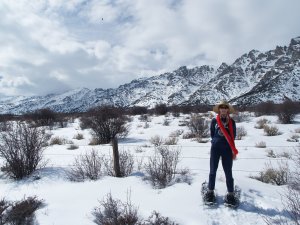 |
Llamas, or perhaps Alpacas, near
our Home in Ruby Valley, Nevada
Q: Do you know the difference?
A: Four inches at the shoulder. |
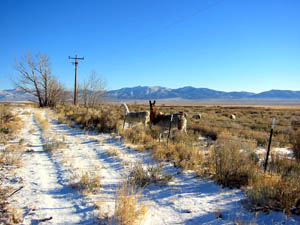 |
Spring 2008 in Ruby Valley
Q: Who Pruned this Tree?
A: Tasty Animals. |
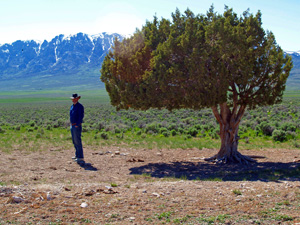 |
Bill and Carol Hoover at Grizzly Flat, California
Q: What is that equation?
A: Something lacking both uniqueness and chaos. |
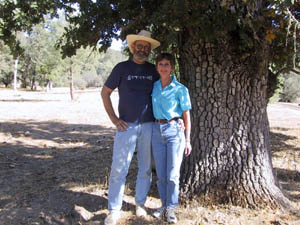 |
Bill and Carol Hoover in Elko, Elko County, Nevada
Q: Who is about to be baptized?
A: The sweet young thing in white ("ux"). |
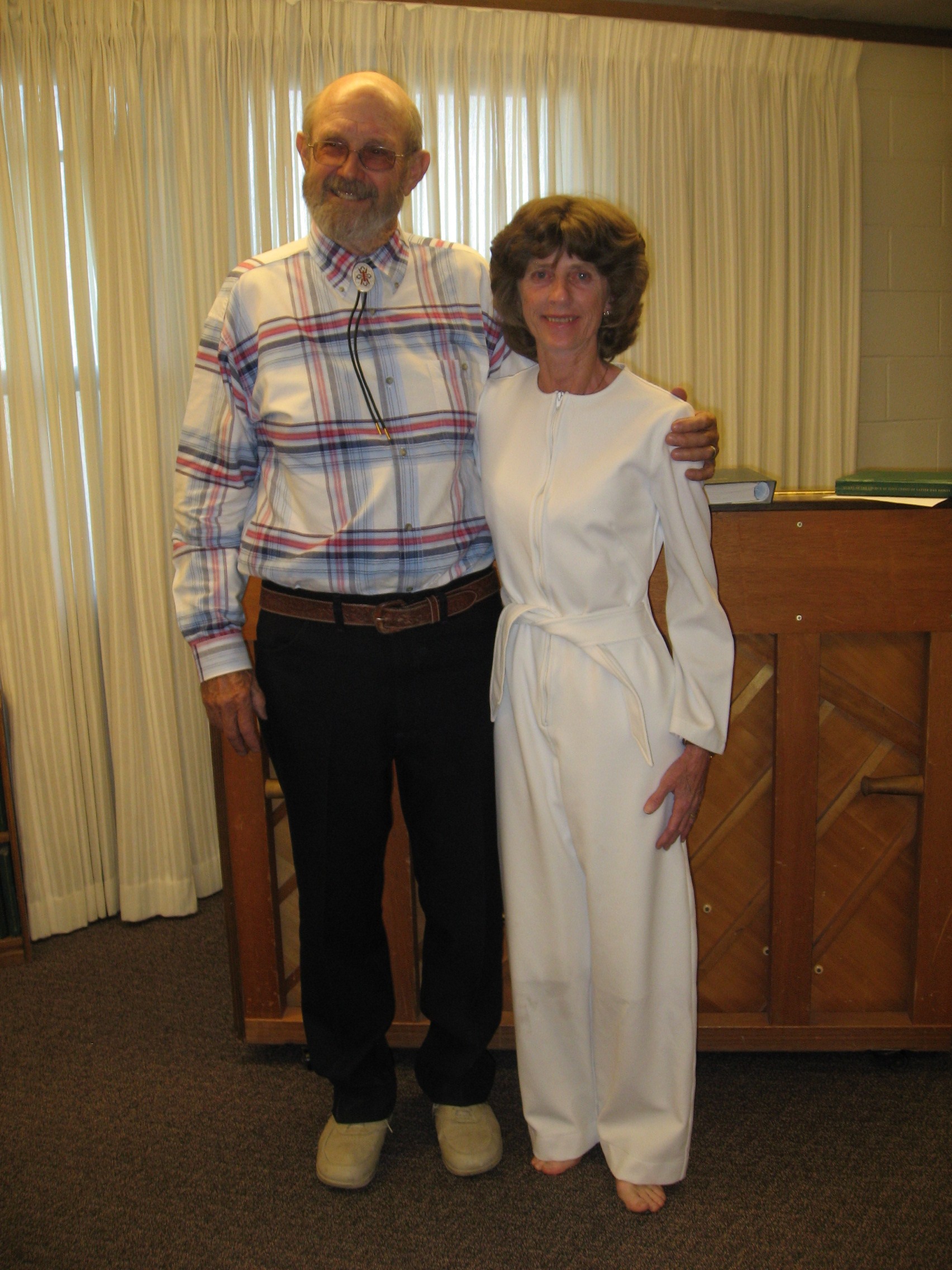 |
Prior to the 2014 Snook Memorial Meeting in Melbourne
Q: Where were the Hoovers?
A: Alpine National Park, Australia. |
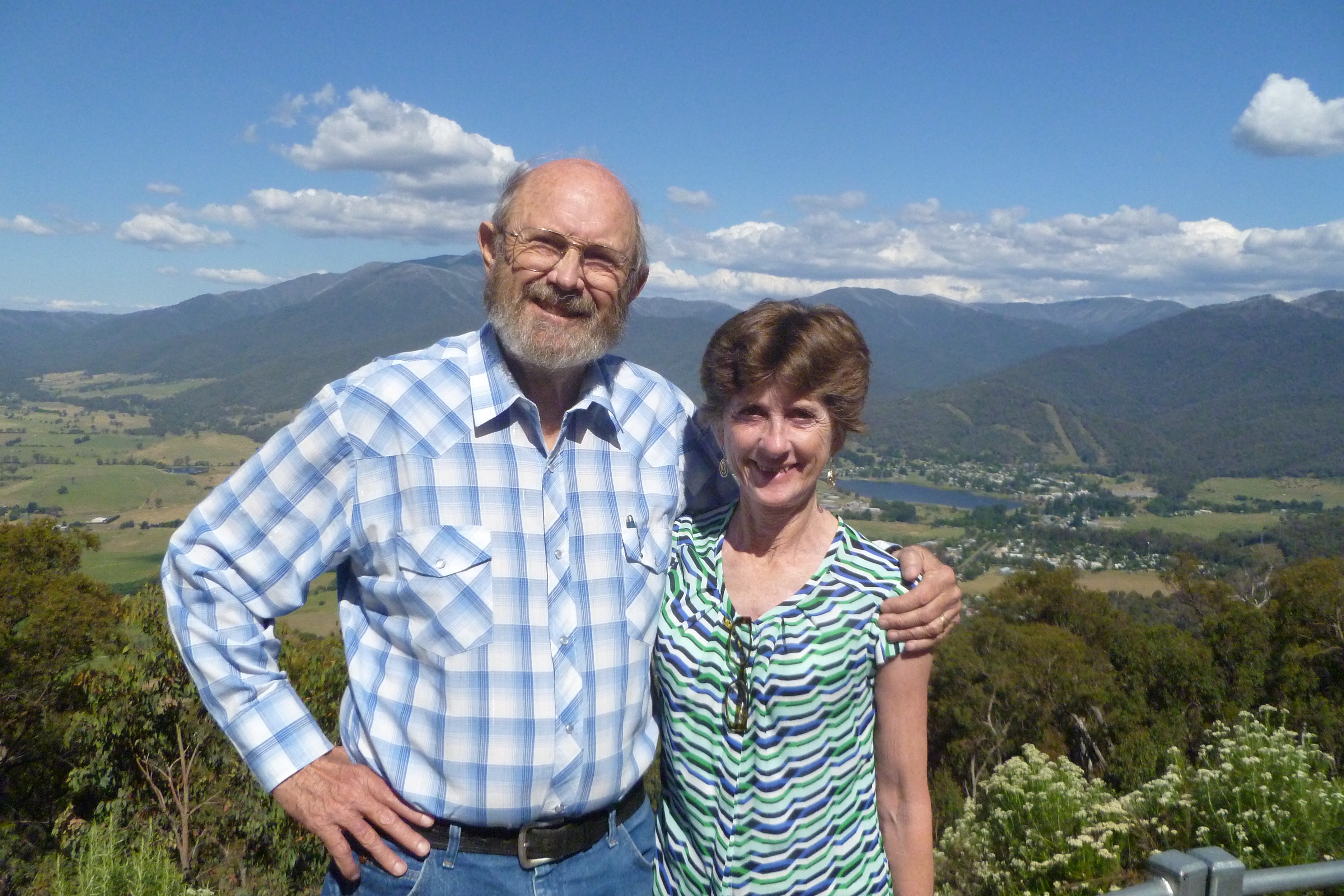 |
More family pictures
After four successful years Our Country has turned left with the incompetent Biden/Harris administration. An idea of Biden's state of mind can be found on his Baltimore "Town Hall" with Anderson Cooper, readily available on YouTube.
Global Warming Evidence, 2008
Book release 2018 :
"Microscopic and Macroscopic Simulation Techniques: Kharagpur Lectures" was released in March 2018. Here is the description of the book, taken from the back cover:
This book aims to provide an example-based education in numerical methods for atomistic and continuum simulations of systems at and away from equilibrium. The focus is on nonequilibrium systems, stressing the use of tools from dynamical systems theory for their analysis. Lyapunov instability and fractal dimensionality are introduced and algorithms for their analysis are detailed. The book is intended to be self-contained and accessible to students who are comfortable with calculus and differential equations.
The wide range of topics covered will provide students, researchers and academics with effective tools for formulating and solving interesting problems, both atomistic and continuum. The detailed description of the use of thermostats to control nonequilibrium systems will help readers in writing their own programs rather than being saddled with packaged software.
To order the book, click here.
The IAN SNOOK PRIZE.
Ian Snook ( 13 June 1945 - 7 April 2013 ) was an Australian computational physicist of the best sort: smart but modest, enthusiastic, tireless,
supportive, and optimistic. A detailed biography, written by his colleague Peter Daivis at the Royal Melbourne Institute of Technology, can be
found at www.iansnook.com . The Hoovers, joined in 2015 by the journal Computational Methods in Science and Technology ( Poznań ) have chosen
to honor his memory through an annual Ian Snook Prize, awarded for the best short paper addressing an interesting problem relevant to statistical
mechanics.
The 2013 Prize was awarded to Federico Ricci-Tersenghi for his algorithm generating a time-reversible random number generator, described in arXiv 1305.1805 . The 2014 Prize was awarded to William Hoover, Puneet Patra, and Clint Sprott in recognition of their work establishing the ergodicity of simple time-reversible deterministic thermostats, as outlined in arXiv 1501.03875 . The 2015 Prize was awarded to Puneet Patra for his original work, "Two-Dimensional Time-Reversible Ergodic Maps with Provisions for Dissipation". The 2016 Prize was awarded to Diego Tapias, Alessandro Bravetti, and David Sanders, for their manuscript "Ergodicity of One-Dimensional Systems Coupled to the Logistic Thermostat". The 2017 Prize was awarded to Kenichiro Aoki for "Symmetry, Chaos, and Temperature in the One-Dimensional Lattice phi-4 Theory" with an Honorable Mention to Timo Hofmann and Jochen Merker for their work, "On Local Lyapunov Exponents of Chaotic Hamiltonian Systems". All these prize-winning papers are available on the cmst.eu website. No prize was awarded in 2018.
Entries for the 2019 Prize of $1000.00 US are to be submitted directly to Computational Methods in Science and Technology [ www.cmst.eu ] and are not to exceed thirty journal pages in length. The journal has no page charges or charges for color illustrations. Entries for the 2019 Prize can be contributed any time prior to 1 January 2020. The 2019 Prize Problem is announced on page 5 of the first number of Volume 25 of CMST for 2019. Briefly, the 2019 Snook Prize Problem is "a detailed investigation of the two-body phi-4 problem from the standpoints of Hamiltonian chaos and Kolmogorov-Arnold-Moser tori and from the goal of an isoenergetic time-reversible algorithm for the microcanonical Gibbs ensemble." More details of the Problem can be found on pages 159-162 of Volume 24(2) of Computational Methods in Sciences and Technology ( at CMST.eu ). ( As usual, previous winners are ineligible. )
Rationale for this Web Page
Books:
"Molecular Dynamics" (Volume 258 in the Springer-Verlag series, Lecture
Notes in Physics, published in 1986, and evidently out of print in 2007.
I found one copy for sale at $121.17 on Amazon.com in May 2007 and
decided to scan the book to make it available for interested readers.) By
2016 both "Molecular Dynamics" and "Computational Statistical Mechanics" were
readily available on Amazon.
"Computational Statistical Mechanics"
(A comprehensive treatment of
equilibrium and nonequilibrium methods and applications, published by
Elsevier in 1991 as Volume 11 of the Studies in Modern Thermodynamics
Series). The .pdf file here was provided through the courtesy of the
Lawrence Livermore National Laboratory.
"Time Reversibility, Computer Simulation, and Chaos" (1999, 2001)
(An up-to-date
description reconciling the irreversible nature of real life with the
time-reversible descriptions of nonequilibrium molecular dynamics,
published by World Scientific as Volume 13 of the Advanced Series in
Nonlinear Dynamics, 1999, reprinted with minor corrections in 2001).
"Time Reversibility, Computer Simulation, Algorithms, Chaos" (2012)
(A revised and expanded up-to-date version of World Scientific's
Volume 13 above).
"Smooth Particle
Applied Mechanics---The State of the Art" (Thorough
description of the use of mesoscopic/macroscopic particles to simulate
the properties of bulk matter, published
by World Scientific as Volume 25 of the Advanced Series in Nonlinear
Dynamics, 2006). There is a free 107 megabyte
draft copy available.
Koichiro Shida [currently at Tokyo City University] kindly translated all four of these books into
Japanese, culminating with publication of the
SPAM book just in time for Christmas of 2008. The second printing was
finished in time for Christmas 2009.
"Simulation and Control of Chaotic Nonequilibrium Systems" (This book provides a thorough study of thermodynamic control of nonequilibrium systems and related
research topics. It is published by World Scientific as Volume 27 of the Advanced Series in Nonlinear Dynamics). Dr Shida kindly translated this book into Japanese in 2016.
Reviews:
"Links Between Microscopic and Macroscopic Fluid Mechanics" (with Carol
Hoover---this paper was rejected by the American Journal of Physics) [Molecular
Physics 101, 1559 (2003)]
"Mécanique de Nonéquilibre à la Californienne" [Physica
A 240, 1 (1997)]
"Nonequilibrium Molecular Dynamics; the first 25 years" [Physica A 194,
450 (1993)]
Conference Proceedings
Contributions and Older Papers with Some Historical or Word-processing
Interest:
"Adiabatic Hamiltonian Deformation, Linear Response Theory, and
Nonequilibrium Molecular Dynamics" (presented at Sitges, Spain at a
1980 conference in memory of Mel Green -- typed on an IBM Selectric! A
Kewpie Doll drawing accompanying the manuscript was removed by the Editors.)
[Springer-Verlag Lecture Notes in Physics 132]
"Atomistic Computer Simulations" (presented at Boulder, Colorado at
Howard Hanley's seminal 1982 conference on Nonlinear Fluid Phenomena --
Looks a bit like teX.)
[Physica 118A, 111 (1983)]
"Nonequilibrium Molecular Dynamics at Livermore and Los Alamos"
(presented at Alghero, Sardinia at a
1991 conference celebrating Berni Alder's 65th birthday -- Microscoft Word.
The Kewpie Doll Poster from the 1980 Edmonton IUPAP meeting appears here.)
[NATO Advanced Science Institutes in Physics, 292B]
"Computer Simulation of Nonequilibrium Processes"
(presented at Monterey, California at the
[1987 Shockwaves in Condensed Matter conference] -- B. Moran, B. L. Holian,
H. A. Posch, and S. Bestiale
are cited as coauthors -- prepared with an IBM Selectric). Two rejection
letters from 21 April 1987 are also included. The
[first]
is from George Bas-Bas at Physical Review Letters
(regarding "Second-Law Irreversibility of Reversible Mechanical Systems",
which was submitted again on 4 May 1987 and published in
[Physical Review
Letters 59, 10-13 (1987)] as "Resolution of Loschmidt's Paradox: the Origin
of Irreversible Behavior in Reversible Atomistic Dynamics". The latter
work is exactly the same as the rejected paper but with the authors'
names permuted and the title changed. The
[second rejection letter](in his
own hand) is from Joel Lebowitz at the Journal of Statistical Physics,
regarding the paper "Reversible Mechanics and Time's Arrow", written for a
volume he collated honoring Ilya Prigogine. This latter paper was next
sent to Physical
Review A, also on 4 May 1987, and was published in the 1 January 1988 issue
of
[Physical Review A 37, 252-257]. These papers illustrate some of the
difficulties in publishing novel work.
Preprints:
"Local Gram-Schmidt and Covariant Lyapunov Vectors and Exponents for
Three Harmonic Oscillator Problems" (For our updated
book on Time Reversibility, Computer Simulation, and Chaos)
A loose translation of some of the covariant literature; with Carol Hoover.
This paper was submitted and accepted on 23 June with the help of Stefano
Ruffo, appearing electronically in Communications in Nonlinear
Science and Numerical Simulation on 25 June 2011 and in printed form in
volume 17, pages 1043-1054 in February 2012. This rapid publication
is a welcome preview of the internet future.
"Free Energy Changes, Fluctuations, and Path Probabilities" (For use in our updated
book on Time Reversibility)
Fluctuation Theorems and Path Probabilities; with Carol Hoover.
"Maxwell and Cattaneo's Time-Delay Ideas Applied to Shockwaves and the
Rayleigh-Bénard Problem" (Originally intended for
Physics Letters A)
Stability of shockwaves and convective rolls with Maxwell's (as opposed
to Cattaneo's) time delay; with Francisco Uribe and Carol Hoover.
"Three Lectures: NEMD, SPAM, and Shockwaves" (For presentation at
La Herradura, Spain,in September 2010)
Reviews of nonequilibrium molecular dynamics and smooth particle applied
mechanics along with new results on modeling dense-fluid shockwaves and
analyzing dynamical instabilities within the waves with local Lyapunov
exponents and phase-space growth rates.
"Flexible Macroscopic Models for Dense-Fluid Shockwaves: Partitioning
Heat and Work; Delaying Stress and Heat Flux; Two-Temperature Thermal
Relaxation" (For presentation at
the 2010 Conference: Advanced Problem in Mechanics, sponsored by the
Russian Academy of Science, and delivered at Saint Petersburg in July)
Within shockwaves the model described here partitions heat and work
separately between the longitudinal and transverse directions of the flow.
"Time-Reversal Symmetry and Covariant Lyapunov Vectors for Simple Particle
Models in and out of Equilibrium" (Physical Review E 82,
046218 (2010))
Comparison (mostly by Bosetti, Posch, and Dellago) of Gram-Schmidt and
Covariant Lyapunov Exponents with Local Bounds, emphasising the fractal
nature of such analyses. The physical significance of the covariant
exponents and vectors is not particularly clear and needs more work.
Memorial Lecture:
"Nosé-Hoover Nonequilibrium Dynamics and Statistical Mechanics." [41
Vugraphs (19 megabytes!)
for the Symposium on Progress and Future Prospects in Molecular Dynamics
Simulation in Memory of Professor Shuichi Nosé (Yokohama, 6-8 June 2006)]
(8 June 2006)
2016 Lectures:
"From Ann Arbor to Sheffield : Around the World in 80 Years. I." [19 Vugraphs (15 megabytes)
for Bill's 80th Birthday Celebration at Sheffield]
(26 July 2016)
"From Ann Arbor to Sheffield : Around the World in 80 Years. II." [17 Vugraphs (10.4 megabytes)
for Bill's 80th Birthday Celebration at Sheffield]
(also 26 July 2016)
"KHARAGPUR LECTURE 1" [33 Vugraphs (27 megabytes)
for Baidurya Bhattacharya's GIAN course at IIT December 2016]
(IIT-1)
"KHARAGPUR LECTURE 2" [31 Vugraphs (25 megabytes)
for Baidurya Bhattacharya's GIAN course at IIT December 2016]
(IIT-2)
"KHARAGPUR LECTURE 3" [32 Vugraphs (21 megabytes)
for Baidurya Bhattacharya's GIAN course at IIT December 2016]
(IIT-3)
"KHARAGPUR LECTURE 4" [25 Vugraphs (9 megabytes)
for Baidurya Bhattacharya's GIAN course at IIT December 2016]
(IIT-4)
"KHARAGPUR LECTURE 5" [25 Vugraphs (20 megabytes)
for Baidurya Bhattacharya's GIAN course at IIT December 2016]
(IIT-5)
"KHARAGPUR LECTURE 6" [33 Vugraphs (6 megabytes)
for Baidurya Bhattacharya's GIAN course at IIT December 2016]
(IIT-6)
"KHARAGPUR LECTURE 7" [21 Vugraphs (17 megabytes)
for Baidurya Bhattacharya's GIAN course at IIT December 2016]
(IIT-7)
"KHARAGPUR LECTURE 8" [23 Vugraphs (5 megabytes)
for Baidurya Bhattacharya's GIAN course at IIT December 2016]
(IIT-8)
"KHARAGPUR LECTURE 9" [24 Vugraphs (4 megabytes)
for Baidurya Bhattacharya's GIAN course at IIT December 2016]
(IIT-9)
"KHARAGPUR LECTURE 10" [26 Vugraphs (22 megabytes)
for Baidurya Bhattacharya's GIAN course at IIT December 2016]
(IIT-10)
"KHARAGPUR LECTURE 11" [33 Vugraphs (26 megabytes)
for Baidurya Bhattacharya's GIAN course at IIT December 2016]
(IIT-11)
2015 Lectures:
"An Appreciation of Berni Julian Alder" [18 Vugraphs (22 megabytes)
for the 90th Birthday Symposium of Berni Alder at LLNL-Livermore]
(20 August 2015)
"An Appreciation of Berni Julian Alder" [Manuscript for the Festschrift as resubmitted to
the Los Alamos arXiv on 17 October 2015 after the initial submission was placed "on hold"
by the arXiv moderators, who suggested it be submitted as a "historical" contribution. After
the resubmission as "historical" the manuscript was again put "on hold" on 19 October,
"submitted" on October 20, and appeared 21 October, safe and sound ! ]
(Manuscript)
"Shockwaves with Molecular Dynamics and Continuum Mechanics" [38 Vugraphs (17 megabytes)
for the Nonequilibrium Simulation School at Sheffield UK]
(3 September 2015)
"Nosé, Posch, Patra, Sprott" [19 Vugraphs (25 megabytes)
for the Department of Physics at the University of Vienna]
(7 September 2015)
2014 Lectures:
" 'What is Liquid?' from the Perspective of Simulations" [25 Vugraphs (5 megabytes)
for the 80th Birthday Symposium of Doug Henderson at BYU-Provo]
(16 August 2014)
"1984+30, The Legacy of Shuichi Nosé's Work" [29 Vugraphs (11 megabytes)
for the 30th Anniversary Symposium at Keio University's Mita Campus (Tokyo)]
(10-11 November 2014)
"Finite Precision, Periodic Orbits, Boltzmann's Constant, Nonequilibrium Entropy" [Poster: (16 Vugraphs, 7 megabytes)
for the 30th Anniversary Symposium]
(Tokyo Poster)
"Time Reversibility and Ergodicity - Snook Prize Topics for 2014" [18 Vugraphs (15 megabytes)
for the Ian Snook Conference on Chemical Physics (Royal Melbourne Institute of Technology)]
(4-5 December 2014)
2012 Lectures:
"Microscopic Reversibility versus Macroscopic Irreversibility" [36 Vugraphs (23 megabytes)
for Saint Petersburg, Russia.]
(Bill's Talk, 3 July 2012)
"Microscopic and Macroscopic Rayleigh-Bénard Flows : Continuum and Particle Simulations,
Fluctuations, Time Reversibility, Uniqueness, and Lyapunov Instability" [48 Vugraphs (10 megabytes)
for Saint Petersburg, Russia.]
(Carol's Talk, 3 July 2012)
2010 Lectures:
"Two-Temperature Time-Delayed Dense-Fluid Shockwaves with Molecular Dynamics
and Continuum Mechanics" [35 Vugraphs (3 megabytes)
for Saint Petersburg, Russia and La Herradura, Spain.]
( 1 July 2010)
"Smooth Particle Applied Mechanics: The Method, with Three Example
Problems" [20 Vugraphs (4 megabytes)
for Saint Petersburg, Russia.]
( 5 July 2010)
"Nonequilibrium Molecular Dynamics" [37 Vugraphs (5 megabytes)
for La Herradura, Spain.]
( 15 September 2010)
2009 Lectures:
"Shockwaves with Molecular Dynamics" [35 Vugraphs (29 megabytes!) for Warwick.]
(May 2009)
"Squares, Cubes, Disks, Spheres" [36 Vugraphs (15 megabytes) for Manchester.]
(Spring 2009)
2007 Lectures:
"Hamiltonian Thermostats for Nonequilibrium Molecular Dynamics Simulations." [52
Vugraphs (29 megabytes!)
for Mexico, Wien, Gdansk, and Melbourne.]
(January 2007)
"SPAM (Smooth Particle Applied Mechanics)." [39
Vugraphs (15 megabytes)
for Mexico City Workshop organized by Paco Uribe.]
(Workshop 2007)
"Computational Physics with Particles." [26
Vugraphs (19 megabytes)
for September Meeting on the Hel Peninsula, Poland, and similar to a talk
delivered in Melbourne at the November MM2007 meeting.]
(Gdansk Talk 2007)
"Nonequilibrium Statistical Mechanics--The Facts and Fundamentals." [37
Vugraphs (26 megabytes)
for a November seminar at Swinburne University (Melbourne, hosted by
Billy Todd).]
(Swinburne Talk 2007)
Some Publications, from
2000-2010:
"Shockwaves and Local Hydrodynamics; Failure of the Navier-Stokes Equations"
[in New Trends in Statistical Physics, Festschrift in Honor of Leopoldo
García-Colín's 80th Birthday, Alfredo Macias and Leonardo Dagdug, Editors
(World Scientific, Singapore, 2010)] (Festschrift Paper)
pointing out a shortcoming of Navier-Stokes Hydrodynamics.
"Well-Posed Two-Temperature Constitutive Equations for Stable Dense Fluid
Shockwaves using Molecular Dynamics and Generalizations of
Navier-Stokes-Fourier
Continuum Mechanics"
[For Presentation at Saint Petersburg in 2010] [Physical Review E 81,
046302 (2010)]
"50 Years of Computer Simulation --- a Personal View"
[Ensemble 12, 17-29 (2010), in Japanese, translated by Masaharu Isobe
with the assistance of our Ruby Valley neighbor, Adam Neff ] (English Version)
or (Japanese translation).
"Single-Speed Molecular Dynamics of Hard Parallel Squares and Cubes"
[with Carol Hoover and Marcus Bannerman] (Single-Speed)
a study of dynamics and phase transitions for hard parallel squares and cubes;
Journal of Statistical Physics, electronic version, 21 July 2009.
"Tensor Temperature and Shockwave Stability in a Strong Two-Dimensional
Shockwave"
[with Carol Hoover] (Shock Stability)
a study of density, temperature, and overall stability of planar shockwaves
in two dimensions; Physical Review E 80, 011128 (July, 2009).
"Nonlinear Stresses and Temperatures in Transient Adiabatic and Shear
Flows via Nonequilibrium Molecular Dynamics -- Three Definitions of
Temperature." [with Carol Hoover, a followup of Physical Review E 78,
046701 (2008), appearing as Physical Review E 79, 046705 (2009)] (Three Temperatures)
exploring
the differences between adiabatic and isoenergetic shear flows which also
demonstrates that configurational temperature contains spurious
rotational contributions.
"Microscopic and Macroscopic Stress with Gravitational and Rotational Forces"
[with Carol Hoover and Jim Lutsko] (Zhou)
a pedagogical study of Zhou's work on the Irving-Kirkwood stress tensor;
Physical Review E 79, 036709 (2009).
"Simulation of Two- and Three-Dimensional Dense-Fluid Shear Viscosities via
Nonequilibrium Molecular Dynamics. Comparison of Time-and-Space-Averaged
Stresses from Homogeneous Doll's and Sllod Shear Algorithms with those from
Boundary-Driven Shear." [Physical Review E 78, 046701 (2008).]
(Shear Flow Comparison)
"Nonequilibrium Temperature and Thermometry in Heat-Conducting Phi-4 Models"
[Physical Review E 77, 041104 (2008).]
(Kinetic and Configurational
Thermostats far from Equilibrium 2008)
"Computational Physics with Particles" [American Journal of Physics 76,
481-492 (2008).]
(Gdansk ms 2007)
"Computational Physics with Particles---Nonequilibrium Molecular Dynamics
and Smooth Particle Applied Mechanics" [this shortened version of our review
appears in Computational Methods in Science and Technology 13, 83-93 (2007).]
(Gdansk Proceedings
2007)
"50 Joint Explorations, 1985-2007." [with Carol Hoover; this informal review
of our joint work with Harald Posch is archived with the Schroedinger Institute
in Vienna as Preprint 1898.]
(Wien 2007)
"Nosé-Hoover Nonequilibrium Dynamics and Statistical Mechanics." [written
for the Symposium on Progress and Future Prospects in Molecular Dynamics
Simulation in Memory of Professor Shuichi Nosé (Yokohama, 6-8 June
2006); Molecular Simulation 33, 13-19 (2007).]
(Spring 2006)
"Phase-Space Growth Rates, Local Lyapunov Spectra, and Symmetry Breaking
for Time-Reversible Dissipative Oscillators." [with Carol Hoover and Florian
Grond; Communications in Nonlinear Science and Numerical
Simulation 13, 1180-1193 (2008)].
(Fall 2006)
"Hamiltonian Dynamics of Thermostated Systems: Two-Temperature
Heat-Conducting phi-4 Chains." [with Carol Hoover; honoring the 65th Birthday
of Harald Posch (Wien); Journal of Chemical Physics 126, 164113 (2007);
the Figures which illustrate this preprint can
also be found as slides 41, 43, 44, and 46 in the first
"January 2007" Lecture below].
(Spring 2007)
"Nosé Shuichi, 17 June 1951 --- 17 August 2005, In Memorium."
[ Butsuri 60, 819 (2005)]
(Shuichi)
"Smooth-Particle Phase Stability with Density and Density-Gradient
Potentials." (with C. G. Hoover) [ Physical Review E 73, 016702
(2005)]
(Summer 2005)
"Searching for Auxetics with DYNA3D and ParaDyn." (with C. G. Hoover)
[Physica Status Solidi (b) 242, 585-594 (2005)]
(October
2004)
"Nonequilibrium Molecular Dynamics: Reversible Irreversibility from Symmetry
Breaking, Thermostats, Entropy Production, and Fractals." [Proceedings of the
Segunda Reunión Mexicana sobre Física Matemática y
Física Experimental, AIP Conference Proceedings 757, 16-28 (2005)]
(September
2004)
"The Second Law of Thermodynamics and MultiFractal Distribution Functions:
Bin Counting, Pair Correlations, and the [definite failure of the]
Kaplan-Yorke Conjecture" (with C. G.Hoover, H. A. Posch, and J. A. Codelli;
after four inconclusive months at Physica D this paper was rescued by
Stefano Ruffo) [Communications in Nonlinear Science and Numerical Simulation, edited by
Chen, Li, Luo, and Ruffo]. It became available online 7 April 2005 and
eventually appeared in volume 12, pages 214-231 in this Journal (which offers a "rapid
exchange of ideas and techniques") sometime in 2007 (about
two and a half years after its writing).
(August
2004)
"Nonequilibrium Molecular Dynamics" (with C. G. Hoover)[Condensed Matter Physics 8,
247-260(2005)], from the Festschrift celebrating Doug
Henderson's 70th-Birthday Symposium at Brigham Young University]
(July
2004)
"Smooth Particle Applied Mechanics: Conservation of Angular Momentum with
Tensile Stability and Velocity Averaging" (with Carol Hoover and Elizabeth
Merritt) [Physical Review E 69, 016702 (2004)]
"Smooth-Particle Boundary Conditions" (with Oyeon Kum) [Physical Review
E, 68, 017701 (2003)]
"Large-System Phase-Space Dimensionality Loss in Stationary Heat Flows"
(with Harald Posch) [Physica D 187, 281 (2004)]
"Remarks on NonHamiltonian Statistical Mechanics: Lyapunov Exponents and
Phase-Space Dimensionality Loss" (with Harald Posch, Ken Aoki, and Dimitri
Kusnezov) [Europhysics
Letters 60, 337 (2002)]
"Time-Reversible Deterministic Thermostats" (with Ken Aoki, Carol Hoover,
and Stephanie de Groot) [Physica D 187, 253 (2004)] (Dresden
2004)
"Time Reversibility, Computer Simulation, and Chaos" [World Scientific,
Singapore (1999 and 2001)]
"Smooth-Particle Simulations Boundary Conditions" (with Carol Hoover) [Computing
in Science and Engineering 3(2), 78 (2001)]
"Liouville's Theorems, Gibbs' Entropy, and Multifractal Distributions for
Nonequilibrium Steady States" [Journal
of Chemical Physics 109, 4164 (1998)]
"Dynamical Instabilities, Manifolds, and Local Lyapunov Spectra Far From
Equilibrium" (with Carol Hoover and Harald Posch) [Computational Methods
in Science and Technology (Poznan, Poland) 7, 55
(2001)]
"Finite-Precision Stationary States at and away from Equilibrium" (with
Christoph Dellago) [Physical
Review E 62, 6275 (2000)]
Oldies, but Goodies, arranged by Topic:
Equilibrium Statistical Mechanics
Nonequilibrium Molecular Dynamics
Fractals and Irreversibility
Lyapunov Spectra/Singular Value Decomposition
SPAM = Smooth Particle Applied Mechanics
Chronological Publications, arranged by Decades:
[
The 1960s
]; [
The 1970s
]; [
The 1980s
]; [
The 1990s
]; [
The 2000s
]; [
The 2010s ].
Biographical Information for William Graham Hoover
I was born in Boston
on 18 April (remember that famous ride of Paul Revere?) 1936 and lived
later, as a boy, in Maryland, Michigan, Pennsylvania, and Washington, DC.
A chemistry teacher at Woodrow Wilson High School in Washington set me
on the path that took me to Oberlin College (BA in Chemistry, 1958) and
the University of Michigan (MSChem and PhD in Chemical Physics, 1961).
My thesis director at Michigan, Andrew De Rocco, sent me to Jacques Poirier
(Duke University) for a postdoctoral year, after which Berni Alder attracted
me to Livermore, California. Los Alamos was only number two. I spent the
remainder of my research career as a physicist at the University of California's
Livermore Laboratory. I joined the Department of Applied Science
(started by Edward Teller through the Davis Campus of the University and
dismantled in July 2011, after his death, due to the Livermore Laboratory's
growing disinterest in things academic) in 1970 and retired as Professor Emeritus
in 1993. The gradual politization and bureaucratization
of the laboratory and the concurrent decline of the University of California toward
a rock-bottom level of political correctness (shared at least, and perhaps
exceeded, by Oberlin College and the University of Michigan) made an active
retired research career much more attractive than continuing "service" to failing
institutions. We completed our move to Ruby Valley, Nevada with Carol's
retirement (June, 2005). We then completed our work on
four books for World Scientific: "Smooth Particle Applied Mechanics---SPAM:
The State of the Art", "Time Reversibility, Computer Simulation, and Chaos",
"Simulation and Control of Chaotic Nonequilibrium Systems", and "Microscopic and
Macroscopic Simulation Techniques: Kharagpur Lectures". (See above for details).
Our horseback and climbing days are now definitely in the past. Physics, gardening,
along with Carol's keyboard music and sewing, and the occasional visits with friends
and relatives seem to keep us as "busy" as ever.
Biographical Information for Carol Griswold Hoover ["ux"]
I met Bill and that
was it ... .
Some of our Post-Retirement Thoughts on Science and Religion
Moving to Ruby Valley Nevada we entered into a friendly, supportive, and deeply
religious community ( mostly "Mormon" = "LDS" = Church of Jesus Christ of the Latter-Day
Saints ). Carol soon joined the Church through a Baptism ceremony in Elko while Bill
remained an atheist, but enjoys serving in, and attending, the local Church with Carol.
Both of us learned more about the Church, and religion in general,
in our efforts better to understand these two different philosophies. Science and
religion are both directed toward understanding truth. Scientific truth is based on
models of nature ( classical mechanics, quantum mechanics, gravity, special and general
relativity, DNA, evolution via natural selection ) which describe observations in
particular special cases, but always with limitations. Quantum electrodynamics
agrees with certain experiments to 12-digit accuracy. As scientific truths are
never exact, and hence subject to change, some few religious individuals reject
science altogether. This viewpoint is fortunately rare.
Richard Feynman thoughtfully described his own view of Science and Religion in a lunchtime
CalTech YMCA Forum talk, "The Relation of Science and Religion", given on 2 May 1956.
In it he noted that college students often come to question their inherited
religious faith as a result of science courses. Feynman points out the excitement
associated with the will to understand and uncover new knowledge. He emphasizes that
that knowledge ( even the 12-digit-accurate findings of quantum electrodynamics ) is
never absolutely certain. There is always the possibility that new
observations will require modifications of the theoretical science models scientists
use in describing reality. When this questioning attitude is turned toward God, prayer,
miracles, Heaven, Christ's Resurrection, ... it becomes clear that those ideas are all
faith-based rather than the result of reproducible observations. Thus the changing
fact-based approximate truths of science are distinctly different from the unchanging
faith-based absolute truths ( God, Christ, Atonement and Resurrection, and Eternal Life ).
Feynman points out that the two pillars of Western Civilization, Scientific inquiry and
Religious Morality, can appear to be in conflict. His talk finishes with the question :
Can the two ways of approaching truth logically coexist ?
Many religious people, with Francis Collins a prominent example ( Henry Eyring was another )
believe there is no conflict. Christopher Hitchens and Richard Dawkins believe the opposite.
In order to choose between these views a particular religious belief needs to be considered.
We consider here the LDS faith as it is the faith now most familiar to us. An element of the
LDS faith is that our time on earth is a probationary learning period prior to an eternity
spent becoming more Godlike in the company of resurrected Family members and God himself.
Members are guided by the Bible, the Commandments, the Book of Mormon, and the Prophetic
declarations of the President of the Church, currently Russell Nelson, a skilled heart surgeon
prior to his elevation to the Presidency. Those who take the Bible literally necessarily
reject science. Those who believe that scientific models are an adequate description of the
Universe see no need for religion. Many others subscribe sincerely to the Commandments and
certain miracles ( such as the Resurrection of Christ, Jonah in the Whale, and Walking on
Water ) and simultaneously accept science as an approximate description of reality, sometimes
in error where miracles and answers to prayer are concerned.
The pros and cons of science are clear : industrial, informational, and thermonuclear. The pros
and cons of religion depend upon the particular choice of religion. Evidently the Crusades and
Inquisition and the ISIS terrorists are warning flags. Bill additionally thinks that religious
faith dampens the curiousity necessary to creating scientific models. Carol believes in the
truth of experiments and science as well as the truth of a loving God, Christ, and a Plan of
Salvation leading the faithful to eternal life. Both of us believe that the moral behavior
described in the Judaeo-Christian Commandments can lead to a smoothly-functioning society and
to the Good Life. Whether or not one believes in miracles is a choice. Both options are open.
For a cogent criticism of religions see Richard Dawkins' 2006 Bantam Press book ( Houghton
Mifflin Harcourt paperback, 2008 ) "The God Delusion", which is also summarized in a one-hour-plus
YouTube presentation.
Carol G. Hoover's email address (for .jpg or .pdf or .ps files):
hoover1carol@yahoo.com
William G. Hoover's email address: hooverwilliam@yahoo.com
Both Hoover's snail addresses in Nevada: 601 Highway Contract 60, Ruby
Valley, Nevada 89833






